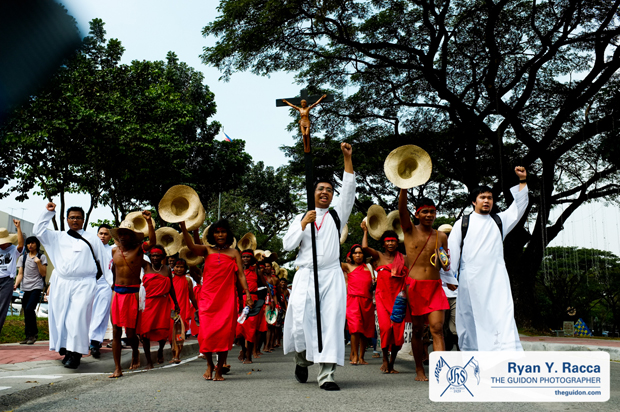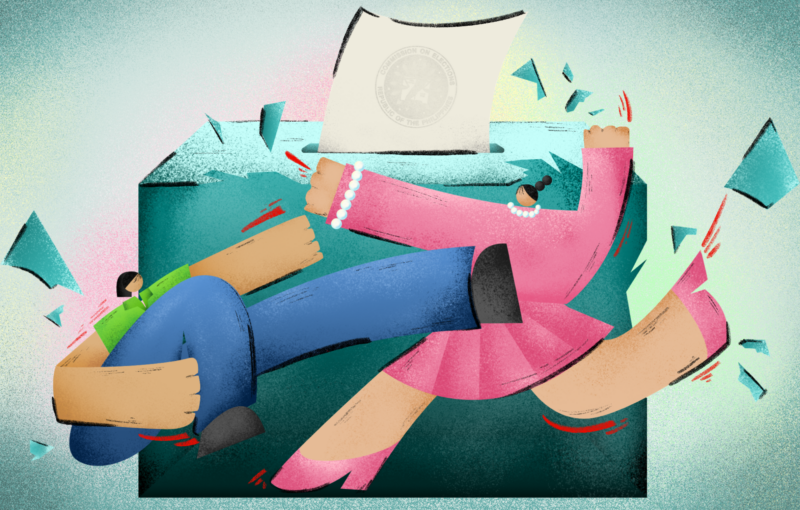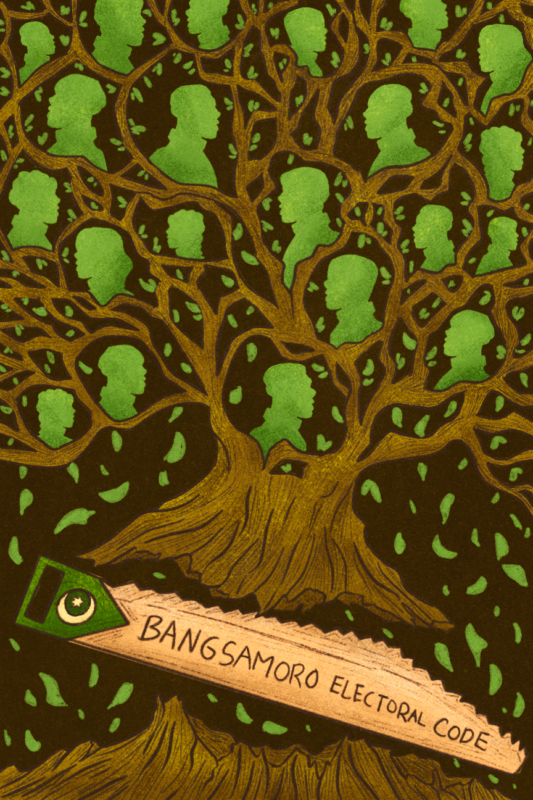The chants reverberated throughout Katipunan.
“Lupa namin, inagaw, inagaw! Bundok namin, inagaw, inagaw! Dagat namin, inagaw, inagaw!”
The marchers had been walking for 17 days, tracing a 350-kilometer route all the way from their hometown of Casiguran, Aurora. They arrived in Metro Manila last December 8, on the 15th day of the march, with the intention of taking their fight to Malacañang to dialogue with the president.
The reception at the Ateneo last Monday morning, December 10, was planned as one of their major stops, with a dialogue with Luis Antonio Cardinal Tagle and a press conference scheduled for the day. True enough, as the marchers approached the campus, a palpable sense of hope took over them. For a group weary from days of sacrifice, it must have been a sight to behold: a huge crowd welcoming them with open arms, passionate about their cause and eager to join them in their fight.
They had been walking for six hours that morning, starting their day in Novaliches and resting only at stops at DAR, UP Diliman and Miriam College. As the 124 marchers from Casiguran and their sizeable entourage of supporters—many of them Ateneans and Jesuits—neared Ateneo Gate 3, the intermittent breaking of voices began to color the chanting. Tears began to flow—visible, though perceptibly restrained, perhaps so as not to detract from the urgency of the struggle at hand.
Nevertheless, the chanting only grew louder and louder. The words took on a newfound audacity in the face of a crowd keen on listening to their plight. “Sinong nang-agaw? Apeco! Angara! Bakit inagaw? Gahaman! Gahaman!”
Everybody was prepared for a protest, but not for a homecoming. As the marchers occupied one of the lanes of the University Road right after entering Gate 3, the welcoming party erupted into cheers. Only their voices were raised higher than their banners, as they echoed the cries of the farmers, the fisher folk, and the indigenous people (IPs) who had come to seek justice from their government.
There was no longer any hesitation: the fight that had to be fought was clear. The crowds coalesced—Atenean, Casiguranin, or otherwise—and what broke out was a chorus unashamed of its demands.
“Lupaing ninuno, ibalik, ibalik! Lupang sakahan, ibalik, ibalik! Pangisdaan, ibalik, ibalik!” Slowly, the marchers—now beefed up in numbers—made their way through the whole stretch of the University Road, their indignation resounding boldly throughout the Ateneo.
Along with the vibrant student movement fighting for Casiguran that the community has come to meet and admire these past few days, The GUIDON stands in solidarity with the marchers and the 2,983 families they represent. We fully support their fight for their ancestral lands, farmlands and fishing grounds, which the Aurora Pacific Economic Zone and Freeport (Apeco) project is threatening to take away.
Apeco is an ongoing multibillion-peso industrial project that aims to develop a 12,923-hectare economic zone in the town of Casiguran. It lapsed into law in 2010 as RA 10083, amending the prior RA 9490 from 2007. The creation of Apeco was spearheaded by Senator Edgardo Angara and his son, Lone District of Aurora Representative Juan Edgardo “Sonny” Angara, with the endorsement of Aurora Governor Bellaflor Angara-Castillo.
On its website, Apeco promises to “promote tourism and rake in investments in aquamarine, agro-industrial, commercial trading, banking, outsourcing and financial industries.”
On the surface, the project looks promising—exciting, even. However, before the proponents of Apeco claim that the project will yield economic progress and development not just for the people of Casiguran but for the entire country, they must first address the numerous legal questions and apparent irregularities hounding Apeco.
There is a need for a thorough review of the previously mentioned law establishing Apeco, which passed in Congress despite inadequate consultation with the people of Casiguran. Rep. Sonny Angara himself admitted as much in a meeting with concerned groups last June 2010 at the Ateneo.
Furthermore, the project violates many other existing laws. For one, Apeco violates the Comprehensive Agrarian Reform Program Extension with Reforms law (RA 9700), as the infrastructural and industrial developments it is expected to put in place will destroy around 300 hectares of agricultural land that serve as a food source for the locals of Aurora. Apeco also failed to follow the Fisheries Code (RA 8550), displacing fisher folk without securing their relocation and support. Additionally, Apeco intrudes into the ancestral lands of the Agta Dumagat without their free, prior and informed consent, in violation of the Indigenous Peoples Rights Act (RA 8371).
Last December 11, the day following their arrival at the Ateneo, the Casiguran marchers met with President Benigno S. Aquino III along with many of his cabinet secretaries in a dialogue at the San Jose Major Seminary covered courts on campus. It was a surprise move—many saw it then as the Palace finding it in its heart to reach out, but now the so-called dialogue only seems to have been a preemptive tactic.
As soon as the marchers voiced out their opposition to Apeco and appealed for Aquino to hold the Apeco budget in order to suspend ongoing constructions, they faced utter disappointment.
Ordering the National Economic and Development Authority (NEDA) to conduct a review of Apeco in the form of a feasibility study, Aquino asked all parties involved to be “open-minded”: “Ako, nakikiusap lang, sana magbukas tayo ng isip. (I’m just asking you to be open-minded.)”
However, in a dismissive and condescending tone he maintained for much of the so-called dialogue, Aquino told the marchers, “Sandali lang ah. Sabi niyo tigilan ko ‘yung budget, o ibigay mo ‘to. Hindi ako diktador eh. Bilang pangulo, chief executive, ano ba ang i-eexecute ko? ‘Yung batas. Kailangan kong ipatupad ‘yung batas. Kung mali ‘yung batas, papalitan natin ‘yung batas. Pero habang batas ‘yan, obligado po akong ipatupad. (Wait a minute. You’re telling me to stop the budget, or give this. I am not a dictator. As the president, chief executive, what should I execute? The law. I have to execute the law. If the law is wrong, we’ll change it. But while [Apeco] is a law, I am obliged to execute it.)”
While Aquino’s respect for due process is nothing but admirable, he falls short of taking his own advice about being open-minded. Throughout the entire so-called dialogue, he was no less than an outright defender of the project. One marcher perhaps said everything that needed to be said as the president exited the venue after the event: “Bingi! (Deaf!)”
The president said that he will base his supposed reconsideration of Apeco on whatever findings the NEDA review will have. However, Aquino fails to see that it is not just the economic assumptions of the project that the protesters are questioning, although it is true that many of the project’s economic assumptions are also built on shaky ground and that the massive amount of money that had been spent on the project so far has yielded all too little for the people of Casiguran. What goes beyond both the economic and legal objections to Apeco is the more human side to the issue—in particular, the competing views of human development at the heart of the dispute.
Lawyer Christian Monsod, the marchers’ legal counsel, offered a proper rebuke to Aquino as he consistently limited his apologetics to technicalities—themselves questionable—and the vague promise of an economic review. “The solutions that we are hearing, while they sound good, do not address that basic premise,” Monsod said to much applause. “That’s why they’re asking for a thorough review of the concept itself of Apeco.”
Apeco is turning out to be a specter raising what may be, to some, uncomfortable questions. Cardinal Tagle was right when he said in his dialogue with the marchers last Monday, “Nagpapasalamat ako dahil sa lakad at pagkwento, nagbibigay kayo sa sambayanang Pilipino ng mahalagang tanong. (I am thankful that because of your march and your stories, you have posed important questions for the Filipino people.)”
Indeed, the issue demands that we revisit what many of us have come to accept as the non-negotiables of a development agenda. There is a need to ask again: what is our idea of development? What is the point of such development in the first place? Who is it for? And what conception of the good do we have that leads the government to intrude into peaceful farming and fishing communities and IPs’ lands for the sake of “investments,” “commercialization,” “industrialization,” and all the other buzzwords of globalization?
One of the most profound confrontations during the tense dialogue last Tuesday came during the speech of Agta tribesman Armand dela Cruz. To a dismissive president the marchers sought out and marched 350 kilometers to meet, he spoke about the simple lives of his people. He spoke about deep contentment, about genuine fulfillment, about happiness—“Nabubuhay kami nang malaya (We live free),” came his striking words.
In the face of such deep happiness, who is the government—or Aquino, or the Angaras, for that matter—to virtually tell these people that they are not truly happy, or that they are not happy enough, and that their happiness can in fact only be secured through the imposition of this aggressive development project on their lives?
The GUIDON stands vehemently against Apeco because, like other development projects of its kind, it misses the point. It mistakes the entry of investors and all sorts of commercial establishments as indicators of true development. Apeco and its proponents in high places are so blinded by the dominant yet overwhelmingly narrow discourses on development that they fail to see genuine happiness where it is present. Instead, they stubbornly insist on their own formulas, revealing an attitude that is insidiously totalitarian and marginalizing.
The so-called dialogue ended with dejection on the part of the marchers. It didn’t take long for the tears to flow freely, for the desperate cries to ring out throughout the venue. Perhaps no one really thought the dialogue would be that futile—never mind that the Apeco CEO attended as part of the government delegation, and that he and the government officials were all coming to each other’s’ defense. Besides, who can blame the farmers, fisher folk and IPs for pinning their hopes on a man who promised them that they would be his boss?
As Aquino left, the eeriness of the scene would have struck anyone who was paying attention. Amid the widespread wailing was the triumphant music on brass instruments, blaring through the loudspeakers to signify the president’s departure. It was a picture of oppression accentuated by “Blue Eagle the King”—apparently our Atenean president’s preferred exit march. It was completely cinematic—breathtaking, even, when you realize that it’s through the kingship of our kind that oppression prevails.
But thank God our kind is a fickle kind. For every little king that comes riding gloriously from the hills of Loyola, there is an Atenean—or twenty—out to offer his or her life for the crucified peoples of the world. And last Monday morning, December 10, on the 153rd anniversary of our school, they were easy to find. They came together in droves at Gate 3, welcoming home those whose homes are in danger.
The fight for the people of Casiguran is not over. We must not stop engaging the government, in hopes that the president, as well as other involved officials, may discern with a deeper understanding of the issue’s implications and with a more heartfelt compassion for the people of Casiguran.
We must assert that the way to achieve true development is through the empowerment of people to genuinely participate in the building of a just society that promotes their authentic human flourishing, not through the marginalizing impositions of the powerful. Thus, in the concrete, we must fight to see that the people of Casiguran are not uprooted from the land that is their life for the sake of Apeco.
The marchers have left the Ateneo last Wednesday, and are now still marching across Manila to continue their protest. They have not lost hope—and that should be reason enough for us not to waver. After all, the fight for the people of Casiguran is also a fight for all the other oppressed peoples of the Philippines.
Let the chants of the marchers reverberate bravely throughout the halls of the Ateneo until we see them through to victory. The fight for Casiguran is not yet done. Tuloy ang laban!







